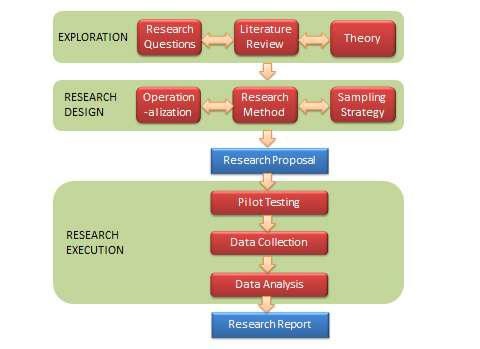Chapter: Research
Overview of the Research Process
.jpg)
Overview of the Research
Process
So how do our mental paradigms shape social science research? At its core, all
scientific research is an iterative process of observation, rationalization,
and validation. In the observation phase, we observe a natural
or social phenomenon, event, or behavior that interests us. In
the rationalization phase, we try to make sense of or the
observed phenomenon, event, or behavior by logically connecting the different
pieces of the puzzle that we observe, which in some cases, may lead to the
construction of a theory. Finally, in the validation phase, we
test our theories using a scientific method through a process of data collection
and analysis, and in doing so, possibly modify or extend our initial theory.
However, research designs vary based on whether the researcher starts at
observation and attempts to rationalize the observations (inductive research),
or whether the researcher starts at an ex ante rationalization or a theory and
attempts to validate the theory (deductive research).
Most traditional research tends to be
deductive and functionalistic in nature. Figure 3.2 provides a schematic view
of such a research project. This figure depicts a series of activities to be
performed in functionalist research, categorized into three phases:
exploration, research design, and research execution. Note that this
generalized design is not a roadmap or flowchart for all research. It applies
only to functionalistic research, and it can and should be modified to fit the
needs of a specific project.

The first phase of research is exploration.
This phase includes exploring and selecting research questions for further
investigation, examining the published literature in the area of inquiry to
understand the current state of knowledge in that area, and identifying
theories that may help answer the research questions of interest.
The first step in the exploration phase is
identifying one or more research questions dealing with a
specific behavior, event, or phenomena of interest. Research questions are
specific questions about a behavior, event, or phenomena of interest that you
wish to seek answers for in your research. Examples include what factors
motivate consumers to purchase goods and services online without knowing the
vendors of these goods or services, how can we make high school students more
creative, and why do some people commit terrorist acts. Research questions can
delve into issues of what, why, how, when, and so forth. More interesting
research questions are those that appeal to a broader population (e.g., 'how
can firms innovate' is a more interesting research question than 'how can
Chinese firms innovate in the service-sector'), address real and complex
problems (in contrast to hypothetical or 'toy' problems), and where the answers
are not obvious. Narrowly focused research questions (often with a binary
yes/no answer) tend to be less useful and less interesting and less suited to
capturing the subtle nuances of social phenomena. Uninteresting research
questions generally lead to uninteresting and unpublishable research findings.
The next step is to conduct a literature
review of the domain of interest. The purpose of a literature review
is three-fold: (1) to survey the current state of knowledge in the area of
inquiry, (2) to identify key authors, articles, theories, and findings in that
area, and (3) to identify gaps in knowledge in that research area. Literature
review is commonly done today using computerized keyword searches in online
databases. Keywords can be combined using
'and' and 'or' operations to narrow down or expand the search
results. Once a shortlist of relevant articles is generated from the keyword
search, the researcher must then manually browse through each article, or at
least its abstract section, to determine the suitability of that article for a
detailed review. Literature reviews should be reasonably complete, and not
restricted to a few journals, a few years, or a specific methodology. Reviewed
articles may be summarized in the form of tables, and can be further structured
using organizing frameworks such as a concept matrix. A well-conducted
literature review should indicate whether the initial research questions have
already been addressed in the literature (which would obviate the need to study
them again), whether there are newer or more interesting research questions
available, and whether the original research questions should be modified or
changed in light of findings of the literature review. The review can also
provide some intuitions or potential answers to the questions of interest
and/or help identify theories that have previously been used to address similar
questions.
Related Topics